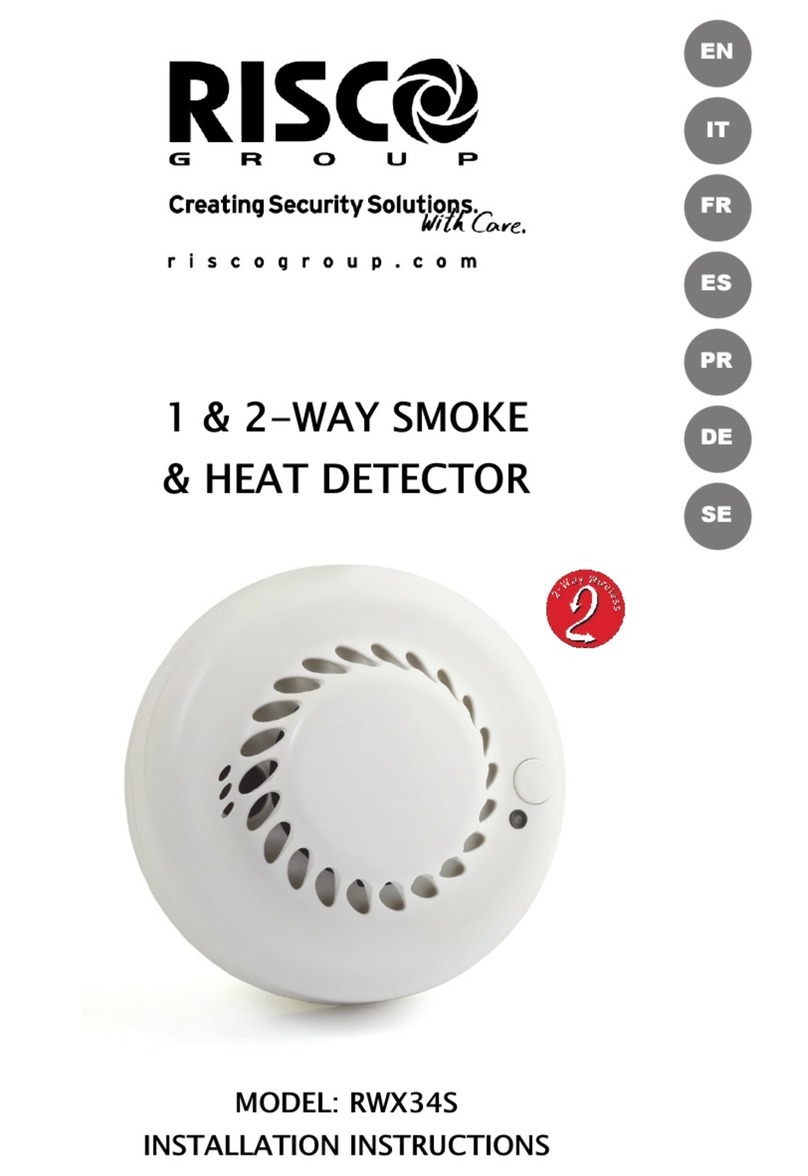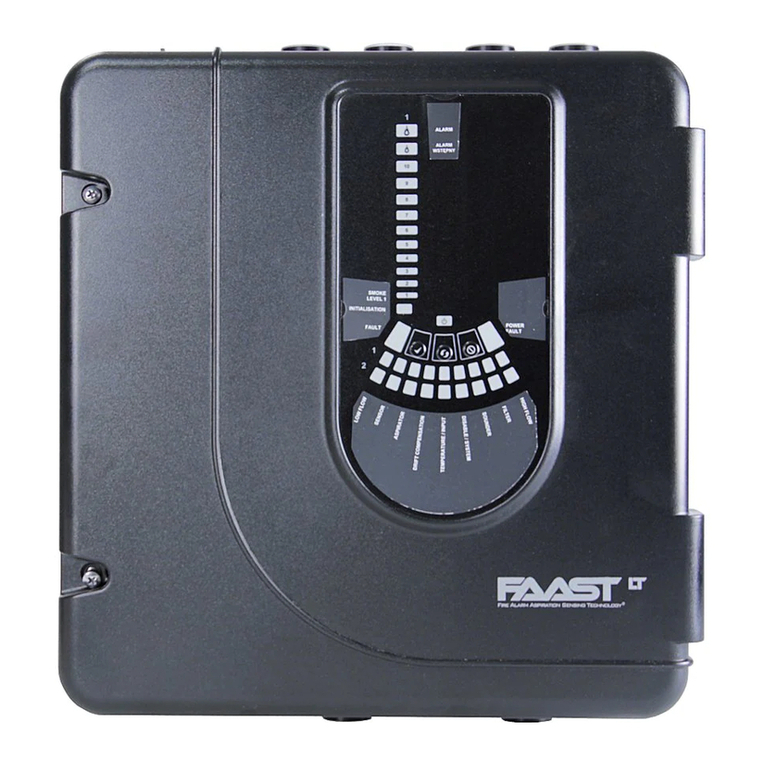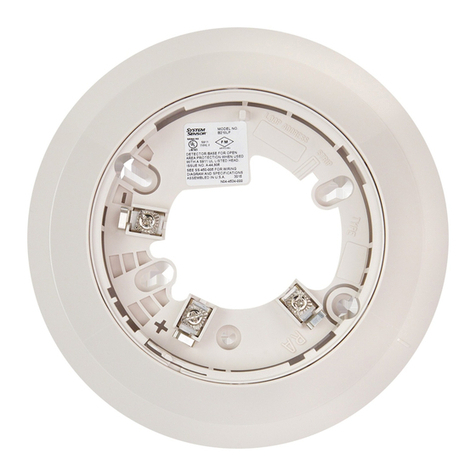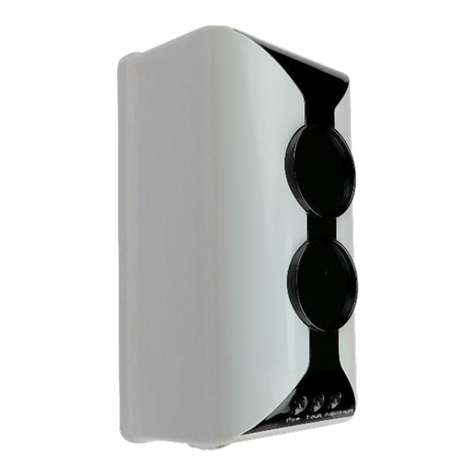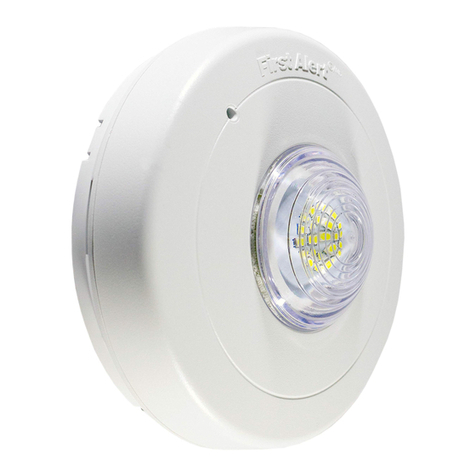Risco EL-5803 User manual

1 & 2-Way Smoke
& Heat Detector
MODEL: EL-5803
INSTALLATION INSTRUCTIONS
www.risco
g
roup.com

2
Language Page
3
17
31
47
63

1 & 2-Way Smoke & Heat Detector 3
EN
GENERAL DESCRIPTION
RISCO Group’s EL-5803 Wireless Smoke and Heat Detector combine advanced
technologies within a compact and streamlined design, the ideal choice for homeowners
seeking the highest safety standards.
Smoke is detected employing an advanced photoelectric chamber, while temperature is
monitored with four separate heat sensors that measure the rate-of-rise, as well as the
absolute temperature. With a choice of selecting either smoke or heat detection or a
combination the two, the Smoke and Heat Detector offers a more sensitive and
dependable product for early detection of fire hazards in different environments with a
reduced risk of false alarms.
The Smoke Detector is EN14604:2005/AC:2008 certified, easy to install, and is compatible
with all Electronics Line’s 1 and 2-way wireless systems.
Main Features:
Wireless, combined smoke and heat detection
Heat-only mode enables installing in harsh environments, such as kitchens or
bathrooms
Earlier detection is achieved from fast temperate rate-of-rise before smoke is
detected
Simple battery replacement performed by the customer
Four heat sensors measuring the fixed temperature and rate-of-rise provide accurate
readings and high false-alarm immunity
Compatible with all Electronic Line’s 1 and 2-way wireless systems
Visual LED indicates alarms, standby mode, and low battery
Built-in test button activates the self test and alarm-sounding
85dB alarm sound
Powered by two CR123 3V lithium batteries (supplied)
Cover and wall tampers

1 & 2-Way Smoke & Heat Detector
4
EN
WARNINGS:
This smoke and heat detector is designed for use in a single residential unit only, which
means that it should be used inside a single family home or apartment. It is not meant to
be used in lobbies, hallways, basements, or another apartment in multi-family buildings,
unless there are already working detectors in each family unit. Smoke and heat detectors
placed in common areas outside of the individual living unit, such as on porches or in
hallways, may not provide early warning to residents. In multi-family buildings, each family
living unit should set up its own detectors.
This detector is not to be used in non-residential buildings. Warehouses, industrial or
commercial buildings, and special purpose non-residential buildings require special fire
detection and alarm systems. This detector alone is not a suitable substitute for complete
fire detection systems for places where many people live or work, such as hotels or
motels. The same is true of dormitories, hospitals; nursing homes or group homes of any
kind, even if they were once single-family homes. Please refer NFPA 101, the Life Safety
Code, NFPA71, 72A, 72B, 72C, 72D, and 72E for smoke and heat detector requirements
for fire protection in buildings not defined as “households”.
SELECTING A LOCATION
Smoke and heat detectors should be installed in accordance with the NFPA Standard 74
(National Fire Protection Association, Batterymarch Park, Quincy, MA 02169). For
complete coverage in residential units, smoke and heat detectors should be installed in all
rooms, halls, storage areas, basements, and attics in each family living unit. Minimum
coverage is one detector on each floor and one in each sleeping area and attic in each
family living unit.
Install a smoke and heat detector in the
hallway outside every separate bedroom
area, as shown in Figure 1. Two detectors
are required in homes with two bedroom
areas, as shown in Figure 2.
Install a smoke and heat detector on every
floor of a multi-floor home or apartment, as
shown in Figure 3.
Install a minimum of two detectors in any
household.
Install a smoke and heat detector inside
every bedroom.
Install smoke and heat detectors at both
ends of a bedroom hallway if the hallway is
more than 40 feet (12 meters) long.
Figure 1: Locations for placing smoke
detectors for single residence with only
one sleepin
g
area

1 & 2-Way Smoke & Heat Detector 5
EN
Install a smoke and heat detector inside
every room where one sleeps with the door
partly or completely closed, since smoke
could be blocked by the closed door and a
hallway alarm may not wake up the sleeper
if the door is closed.
Install basement detectors at the bottom of
the basement stairwell.
Install second-floor detectors at the top of
the first-to-second floor stairwell.
Be sure no door or other obstruction blocks
the path of smoke to the detector.
Install additional detectors in your living
room, dining room, family room, attic, utility
and storage rooms.
Install smoke and heat detectors as close
to the center of the ceiling as possible. If
this is not practical, put the detector on the
ceiling, no closer than 4 inches (10 cm)
from any wall or corner, as shown in
Figure 4.
If ceiling mounting is not possible and wall
mounting is permitted by your local and
state codes, put wall-mounted detectors
between 4 and 6 inches
(10 ~ 15 cm) from the ceiling, also see
Figure 4.
If some of your rooms have sloped,
peaked, or gabled ceilings, try to mount
detectors 3 feet (0.9 meter) measured
horizontally from the highest point of the
ceiling as shown in Figure 5.
Figure 2: Locations for placing smoke and
heat detectors for single-floor residence
with more than one sleeping area
Figure 3: Location for placing smoke and
heat detectors for a multi-floor residence

1 & 2-Way Smoke & Heat Detector
6
EN
CAUTION:
(As required by the California State Fire Marshall)
“Early warning fire detection is best achieved by the
installation of fire detection equipment in all
rooms and areas of the household as follows: (1)
A smoke and heat detector installed in each
separate sleeping area (in the vicinity, but outside
of the bedrooms), and (2) Heat or smoke and
heat detectors in the living rooms, dining rooms,
bedrooms, kitchens, hallways, attics, furnace
rooms, closets, utility and, storage rooms,
basements and attached garages.”
For your information, NFPA Standard 74, Section 2-4
reads as follows:
“2-4.1.1 Smoke and heat detectors shall be installed
outside of each separate sleeping area in the
immediate vicinity of the bedrooms and on each
additional story of the family living unit including
basements and excluding crawl spaces and
unfinished attics.“
The provisions of 2-4.1.1 represent the minimum
number of detectors required by this standard. It
is recommended that the householder consider
the use of additional smoke and heat detectors
for increased protection for those areas separated
by a door from the areas protected by the
required smoke and heat detectors under 2-4.1.1
above. The recommended additional areas are
living room, dining room, bedroom(s), kitchen,
attic (finished or unfinished), furnace rooms, utility
room, basement, integral or attached garage, and
hallways not included in 2-4.1.1 above. However,
the use of additional detectors remains the option
of the householder.” We recommend complete
coverage and use of additional smoke and heat
detectors.
Figure 4: Recommended best and
acceptable locations to mount
smoke and heat detectors
Figure 5: Recommended location to mount
smoke and heat detectors in rooms with
sloped, gabled, or peaked ceiling

1 & 2-Way Smoke & Heat Detector 7
EN
WHERE NOT TO INSTALL YOUR SMOKE AND HEAT
DETECTORS
False alarms occur when smoke and heat detectors are installed where they will not work
properly. To avoid false alarms, do not install smoke and heat detectors as follows:
In the path of fresh air intake. The in-and-out flow of fresh air can drive smoke away
from the smoke and heat detector; thus reducing its efficiency. Figure 6 indicates the
correct and incorrect locations concerning this problem.
Near paint thinner fumes.
In close proximity to an automobile exhaust pipe, as this will damage the detector.
In very cold or very hot areas,
including unheated buildings or
outdoor rooms. If the temperature
goes above or below the detection
range of the smoke and heat
detector, it will not work properly. This
detection range is 40°F to 100°F (4°C
to 38°C).
Near fresh air vents or very drafty
areas like air conditioners, heaters or
fans. Fresh air vents and drafts can
drive smoke away from smoke and
heat detectors.
Dead-air spaces, which are often at
the top of a peaked roof, or in the
corners between ceilings and walls.
Dead air may prevent smoke from
reaching a detector. See Figures 8
and 9 for recommended mounting
locations
Air EntryAir Return
Bath
Bedroom
Bedroom
Living
Room
Kitchen
Stove
Correct Location
Incorrect Location
Figure 6: Recommended smoke and heat
detector locations
In insect-infested areas. If insects enter a detector's sensing chamber, they may
cause a false alarm. Where bugs are a problem, get rid of them before putting up a
detector.
Near fluorescent lights, as electrical "noise" from fluorescent lights may cause false
alarms. Install smoke and heat detectors at least 5 feet (1.5 meters) from such lights.

1 & 2-Way Smoke & Heat Detector
8
EN
WHERE HEAT-ONLY MODE CAN BE USED
Combustion particles are by-products of something burning. To avoid false alarms, you
can install your detectors in heat-only mode in or near areas where
non-dangerous combustion particles are typically present but do not pose a fire hazard,
such as kitchens with few windows or poor ventilation. If the distance from the detector to
places where combustion particles are normally present is less than 20 feet (6 meters) –
such as in kitchens or mobile homes, install only the heat detector as far away from the
combustion particles as possible, preferably on the wall. To prevent false alarms, provide
good ventilation in such places.
IMPORTANT:
Never try to avoid false alarms by disabling the detector.
In damp or very humid areas or near bathrooms with showers. Moisture in humid air
can enter the sensing chamber, and then turns into droplets upon cooling, which can
cause false smoke alarms.
In very dusty or dirty areas, dirt and dust can build up on the detector's sensing
chamber, to make it overly sensitive.
Additionally, dust or dirt can block openings to the sensing chamber and keep the
detector from sensing smoke.
INSTALLATION
The smoke and heat detector is to be mounted on the ceiling or on the wall, if necessary.
Since the smoke and heat detector is a single-station type, it cannot be linked to other
detectors.
WARNING:
Do not connect the smoke and heat detectors to any other alarm or auxiliary
device. Connecting anything else to this detector will prevent it from working
properl
y
.
Read the “Where to install your smoke and heat detector” and “Where not to install your
smoke and heat detectors” sections in this manual before installing.
To install the detector (see Figures 7 & 8)
1. Select the installation location.
2. Remove the locking pin securing the mounting bracket to the unit (see Figure 7).
3. Remove the mounting bracket from the unit by rotating it counterclockwise.
4. Use the bracket as a template for marking the mounting holes.
5. Using an appropriate drill, drill two holes at the marks and insert anchors.
6. Using screws (supplied) attach the bracket to the wall as shown in Figure 7.

1 & 2-Way Smoke & Heat Detector 9
EN
Figure 7: Smoke and heat detector installation
Figure 8: Unit backside: batteries compartment, tamper and DIP switch
DIP Switch
Tamper

1 & 2-Way Smoke & Heat Detector
10
EN
To configure the DIP switch:
Table 1
DIP SW Description ON OFF
1 1-Way/2-Way selection 2-Way* 1-Way
2 Smoke selection Smoke Enabled* Smoke Disabled
3 Heat selection Heat Enabled Heat Disabled*
* default
NOTE:
Configuring the DIP switches should be performed without the batteries connected.
1. [For one-way operating mode]: Set the DIP switch 1 to 1-way, and configure either
smoke (2), heat (3) or smoke and heat.
NOTE:
Changing the DIP switch Smoke (2) to off will cause that Smoke Detector will not comply to
EN14604.
2. [For two-way operating mode]: Set the DIP switch 1 to 2-way, and configure activation
of the Smoke and Heat detectors from the system panel. (In this mode, the DIP switch
2 & 3 settings are irrelevant.)
3. Set the alarm system to registration mode.
a. Go to the main menu and select [9]>[1]>[1] (Programming > Devices > Zones)
b. Select a zone and press '√'
4. Open the battery compartment cover (see Figure 8).
WARNING:
The detector batteries are supplied inside of the unit, which are covered with
plastic wrapping. Remove the plastic wrapping from the batteries before
installation, and then perform a functional test of the detector according to the
Testin
g
section of these instructions.
5. Remove the battery from the insulation material and reinsert it into the transmitter,
paying attention to the polarity.
6. Close the compartment cover.The detector will send a transmission. If the transmission
is successfully received by the system it will play a confirmation sound. If no
confirmation sound is heard send another transmission by pressing and releasing the
tamper switch of the device.
7. After the detector is successfully registered the display shows: Save? Press √ to
confirm and continue entering other parameters for the chosen device.

1 & 2-Way Smoke & Heat Detector 11
EN
WARNING:
This detector is not suitable for installation in a hazardous location, as defined in the national
electrical code. Do not use detector in an outlet controlled by a wall switch.
8. Line up the side slot of the bracket and the detector. Push the detector onto the
mounting bracket and turn it clockwise to secure it into place.
Insert the locking pin in order to secure the mounting bracket to the detector (see
Figure 7).
9. Pull the detector outward to make sure it is securely attached to the mounting bracket.
RED INDICATOR
When the red LED indicator (see Figure 9) flashes once in 30 seconds, it indicates the
detector is operating normally. When the red LED is illuminated continuously, and
simultaneously an audible alarm sounds, this indicates the detector is responding to an
alarm trigger.
DETECTOR PARAMETERS
The following detector parameters can be defined from the system receiver:
Parameter Option
Operational Mode: Smoke only, Heat only or Smoke and Heat
Supervision Time: 1-255
See your system receiver’s installation / configuration manual for more information about
defining detector parameters.

1 & 2-Way Smoke & Heat Detector
12
EN
TESTING YOUR SMOKE AND HEAT DETECTOR
To be sure the detector is working
correctly, test the detector at initial
installation, and then test weekly
by performing the following
procedure:
1. Use your finger to firmly
press the test button. If the
detector is functioning
correctly, the alarm horn
sounds and an alarm
message is sent to the
panel.
2. To stop the alarm horn,
press the test button again.
Figure 9: Smoke and heat detector Cover
If the detector fails to test properly, have it repaired or replaced immediately.
If the alarm horn begins to beep once every 35 seconds, it means that the detector’s batteries
are weak. Replace the batteries immediately. Keep fresh batteries on hand for this purpose.
NOTES:
1. If you wish to perform a spray test, the spray must be at a distance of 20 cm away from the
detector. Press on the spray continuously for at least 5 seconds; the LED will flash every
second for 25 seconds followed by alarm activation.
2. Cooking smoke or a dusty furnace (sometimes called “friendly fires”) can cause the alarm
to sound. If this happens, open a window or fan the air to remove the smoke or dust. The
alarm will turn off as soon as the air is completely clear. If, however, the smoke alarm
continues, activate the heat-only mode. Do not disconnect the batteries from the detector.
This will cancel
y
our protection from fire.

1 & 2-Way Smoke & Heat Detector 13
EN
DELETING THE SMOKE AND HEAT DETECTOR
1. Set the system to delete mode.
a. Go to the main menu and select [9]>[1]>[1] (Programming > Devices > Zones).
b. Select a zone and press '√'
c. Press >12 >√.
2. Open the detector and remove the batteries.
3. Press the tamper switch. While pressing the tamper switch, re-insert the battery.
4. Within 5 seconds open the tamper and close it again.
SMOKE AND HEAT DETECTOR MAINTENANCE
To keep your detector in good working condition, you must test the detector weekly,
according to the “Testing Your Smoke and Heat Detector” section.
CLEANING THE SMOKE AND HEAT DETECTOR
Clean the detector housing with a dry or damp cloth to remove dust and dirt. If necessary,
open the smoke chamber and clean the interior of the detector.
To clean the detector:
1. Remove the detector from the detector base.
2. Remove the batteries.
3. Use a fine paintbrush to remove dirt from the chamber.
4. After cleaning, close the smoke chamber, secure the housing and re-mount the detector
on the ceiling.
DO NOT FORGET TO REPLACE THE BATTERIES!
BATTERY REPLACEMENT
Replace the detector batteries once a year, or immediately whenever the low battery
“beep” signal sounds once every 35 seconds. The low-battery "beep" should last at least
30 days before the batteries die out completely.
To replace the detector batteries:
1. Remove the detector from the plastic mounting bracket..
2. Open the battery compartment cover.
3. Remove the old batteries.
4. Insert the new batteries while observing battery polarity (see Figure 10), and close the
battery compartment cover.
5. Reconnect the detector to the mounting bracket.

1 & 2-Way Smoke & Heat Detector
14
EN
Figure 10: Battery Replacement
NOTE:
If false alarms keep coming from the detector, you should check whether the detector’s location
is adequate. Refer to section “Where To Install Smoke and Heat Detectors.” Have your
detector moved if it is not located properl
y
. Clean the detector as described above.
After you re-mount the detector on its base, you must check the smoke alarm. To do this,
conduct a functional test as described in the Testing section of these instructions.

1 & 2-Way Smoke & Heat Detector 15
EN
WARNING! LIMITATIONS OF SMOKE ALARMS
Wireless smoke alarms are very reliable, but may not work under all conditions. No fire
alarm provides total protection of life or property. Smoke alarms are not a substitute for life
insurance.
Smoke alarms require a source of power to work.
This smoke alarm will not operate and the alarm will not sound if batteries are dead or not
installed properly.
Smoke alarms may not be heard. A sound sleeper or someone who has taken drugs or
alcohol may not awaken if the alarm is installed outside a bedroom. Closed or partially
closed doors and distance can block sound. This alarm is not designed for the hearing
impaired.
Smoke alarms may not always activate and provide warning early enough. Smoke alarms
only activate when enough smoke reaches the alarm. If a fire starts in a chimney, wall,
roof, on the other side of closed doors, or on a different level of the property, enough
smoke may not reach the detector for it to sound its alarm.
Smoke alarms are a significant help in reducing loss, injury and even death. However, no
matter how good a detection device is, nothing works perfectly under every circumstance
and we must warn you that you cannot expect a smoke alarm to ensure that you will never
suffer any damage or injury.
NOTE:
The smoke alarm is not suitable for use in leisure accommodation vehicles.

1 & 2-Way Smoke & Heat Detector
16
EN
Specifications
Certifications:
EN14604:2005/AC:2008
1134-CPR-219
Ordering Information
Model Description
EL-5803 Smoke & Hea
t
Detector, 1 & 2 Wa
y
Smoke Detection Photoelectric chambe
r
Power Output 10mW Max.
Heat Detection Four sensors with fixed temperature and rate-
of-rise
Certification EN14604:2005/AC:2008
Operating Modes Smoke + Heat (OR logic)
Smoke only
Heat onl
y
Wireless RF Modes Selectable 1-wa
y
or 2-wa
y
Alarm Sound Level Exceeds 85dB at 3m
(
10’
)
Typical Average Standby
Current: 0.02mA typical
T
y
pical Alarm Current: 100mA
T
y
pical Batter
y
Life: T
y
picall
y
3
y
ears
Batter
y
T
y
pe: Two CR123 3V lithium batteries
Low Batter
y
Threshold: 2.6 V
Low Batter
y
Beep rate: One beep ever
y
60 seconds
Operatin
g
Temperature: 32°F - 131°F
(
0°C to 55°C
)
Operatin
g
Humidit
y
: 10% to 85% RH, no condensation or icin
g
Color: White
Dimensions: Diameter: 4.25 in (108 mm)
Hei
g
ht: 2 in
(
53 mm
)
Transmitter Characteristics:
Nominal Center Frequency Smoke & Heat Detector, 1 & 2 way 433 MHz
Smoke & Heat Detecto
r
, 1 & 2 wa
y
868 MHz
Supervision Time 15 min. for 868 MHz /
65 min. for 433 MHz

17
IT
RIVELATORE DI FUMO
E CALORE MONO E BIDIREZIONALE
MODELLO: EL-5803
ISTRUZIONI DI INSTALLAZIONE
www.risco
g
roup.com

Rivelatore di Fumo e di Calore radio monodirezionale e bidirezionale
18
IT
DESCRIZIONE GENERALE
Il rivelatore radio di fumo e calore EL-5803 di RISCO Group combina tecnologie avanzate
con un design compatto e moderno e rappresenta la scelta ideale per chi cerca un
prodotto conforme agli standard di sicurezza più elevati.
Il fumo è rivelato utilizzando un’avanzata camera fotoelettrica, mentre la temperatura è
monitorata con quattro diversi sensori di calore che misurano il tasso di crescita e la
temperatura assoluta. Permettendo di scegliere tra la rilevazione di fumo, quella di calore
o entrambe, il Rilevatore di RISCO Group costituisce un prodotto sensibile e affidabile da
utilizzare per la rilevazione incendio, con un minimo rischio di falsi allarmi.
Il Rilevatore è certificato EN14604:2005/AC:2008, è facile da installare ed è compatibile
con tutti i sistemi radio monodirezionali e bidirezionali gamma di Electronics Line.
Caratteristiche principali
Comunicazione via radio della rilevazione combinata di Rilevamento fumo e calore.
La modalità solo calore può essere utilizzata in ambienti difficili come cucine o bagni.
La rilevazione anticipata è ottenuta tramite l’alto tasso di aumento della temperatura,
prima che venga rilevato il fumo.
Sostituzione delle batterie facilmente eseguibile dall’utente.
Quattro sensori misurano la temperatura fissa e il tasso di aumento e forniscono una
lettura precisa evitando falsi allarmi.
Compatibile con tutti i sistemi radio monodirezionali e bidirezionali gamma Electronics
Line di RISCO Group.
Il LED segnala gli allarmi, la modalità stand-by e le batterie scariche.
Il pulsante di test integrato attiva il test automatico e le segnalazioni acustiche di allarme.
Segnalazione acustica dell’allarme di 85 dB.
Alimentato da due batterie al litio CR123 3V (fornite).
Contatto antimanomissione per la rimozione e l’apertura.
AVVERTENZE:
Questo rilevatore è stato progettato per essere utilizzato esclusivamente in un’unica unità abitativa.
Questo significa che deve essere utilizzato all’interno della casa o dell’appartamento di una sola
famiglia. Non è progettato per l’utilizzo in atrii, corridoi, cantine o in altri appartamenti in edifici
plurifamiliari, a meno che non siano già installati dei rivelatori in ogni unità familiare. I rivelatori di
fumo e di calore collocati in aree comuni, fuori dalle singole unità abitative, come verande o
corridoi, possono non garantire una rilevazione efficace. In edifici plurifamiliari, ogni unità familiare
deve installare i propri rilevatori.
Questo rilevatore non deve essere utilizzato in edifici non residenziali. Magazzini, edifici industriali
o commerciali e altre costruzioni non residenziali necessitano di sistemi di rilevazione e di allarme
antincendio speciali. Questo rilevatore, da solo, non è il sostituto di un sistema completo di
rilevazione antincendio per luoghi dove vivono o lavorano molte persone, come hotel o motel. Lo
stesso vale per dormitori, ospedali, case di riposo o case collettive di qualsiasi tipo, anche se in
precedenza erano case monofamiliari. Si prega di fare riferimento al NFPA 101, the Life Safety
Code, NFPA71, 72A, 72B, 72C, 72D, e 72E per i requisiti dei rilevatori di fumo e di calore per la
protezione antincendio di edifici che non sono definiti “residenziali”.

Rivelatore di Fumo e di Calore radio monodirezionale e bidirezionale 19
IT
SCELTA DELLA POSIZIONE PER L'INSTALLAZIONE
I rilevatori di fumo e di calore devono essere istallati conformemente alle norme NFPA
Standard 74 (National Fire Protection Association, Batterymarch Park, Quincy, MA 02169).
Per una copertura completa nelle unità abitative, i rivelatori di fumo e di calore devono
essere installati in tutte le stanze, gli atri, le aree di immagazzinamento, le cantine, le
soffitte dell’unità familiare. La copertura minima è un rilevatore in ogni piano e uno in ogni
zona notte e mansarda di ogni unità familiare.
IMPORTANTE:
La regolamentazione riguardante i sistemi di rilevazione incendio varia da Paese a Paese.
Per ma
gg
iori informazioni contattare le Autorità locali.
Posizionare i rivelatori di fumo e di
calore nel corridoio di accesso ad
ognuna delle camere da letto come
illustrato in figura 1. In abitazioni con
più zone notte, come illustrato in figura
2, vanno installati più rivelatori.
Installare i rivelatori ad ogni piano in di
un condominio con più appartamenti o
un appartamento con più piani come
mostrato in figura 3.
Installare minimo due sensori per
famiglia.
Installare almeno un rivelatore per ogni
camera da letto.
Installare un rivelatore alle due
estremità del corridoio di accesso alle
camere se è più lungo di 12 metri.
Installare i rivelatori del seminterrato
nella parte bassa del vano scala.
del vano scala tra il primo e il secondo
piano.
o non ostruiscano il percorso del fumo
verso il sensore.
Installare rivelatori aggiuntivi in sala da
pranzo, soggiorno, attico, ripostiglio
etc..
Installare i rivelatori quanto più
possibile al centro del soffitto. Se non è
Figura 1: Posizionamento dei rivelatori di fumo e di
calore all’interno di una abitazione con una sola
zona notte.
Figura 2: Posizionamento dei rivelatori di fumo e di
calore all’interno di una abitazione con più zone notte
Sala da Pranzo Cucina
Camera matrim.
Soggiorno
Sensori di Fumo per una minima protezione
Camera
Camera
Sensori di Fumo aggiuntivi per una maggiore
protezione
Sensori di fumo per una minima
protezione
Sensori di fumo aggiuntivi per
una maggiore protezione
Sala da
Pranzo
Cucina
Soggiorno
Camera
letto
Camera
letto
Camera
letto
Camera letto
O O
O

Rivelatore di Fumo e di Calore radio monodirezionale e bidirezionale
20
IT
possibile, installarli ad almento 10
centimetri di distanza dalle pareti della
stanza come mostrato in figura 4.
Se l’installazione a soffitto non è
possibile ed in alternativa è possibile
ed accettata dalle Norme vigenti nel
Paese quella a parete, posizionare i
rivelatori di fumo e di calore ad una
distanza di 10 - 15 cm dal soffitto.
Consultare la figura 4.
Se alcuni soffiti delle stanze sono
inclinati o ad arco, provare a montare il
rivelatore a circa 1 metro, misurato
orizzontalmente dal punto più alto del
soffitto, come mostrato in figura 5.
AVVERTENZA :
(Come richiesto dal Fire Marshall dello Stato
della California)
Un sistema di rilevazione incendio viene
ottenuto mediante l'installazione di
apparecchiature di rilevazione incendio in
tutte le camere e le aree del nucleo familiare
come segue: (1) Un sensore di fumo e
calore installato in ogni zona notte (nelle
vicinanze, ma al di fuori delle camere da
letto) , e (2) uno nei salotti, sale da pranzo,
camere da letto, cucine, corridoi, soffitte,
cabine armadi, ripostigli, cantine e garage
collegati. "
Per vostra informazione, la normativa
standard NFPA 74, sezione 2-4 sostiene:
"2-4.1.1 i rivelatori di fumo e calore devono
essere installati al di fuori di ogni zona notte,
nelle immediate vicinanze delle camere da
letto e in ogni area supplementare compresi
scantinati."
Le disposizioni del 2-4.1.1 rappresentano il
numero minimo di rilevatori richiesti dalla
presente norma. Si raccomanda che il
padrone di casa prenda in considerazione
Figura 6: Posizionamento dei rivelatori di fumo e
calore in una abitazione su più livelli
Figura 4: Posizioni perfetta e accettabile di
installazione dei rivelatori di fumo e di calore
Massimo
15 cm
Soffitto
Minimo
10 cm
Minimo
10 cm
Qui
Mai
Centro del
Soffitto
Posizione perfetta
Posizione accettabile
CAMERA
CAMERA CAMERA
SEMINTERRATO
PIANO
TERRA
CUCINA
RIVELATORI DI FUMO PER UNA
PROTEZIONE MINIMA
Table of contents
Languages:
Other Risco Smoke Alarm manuals
Popular Smoke Alarm manuals by other brands
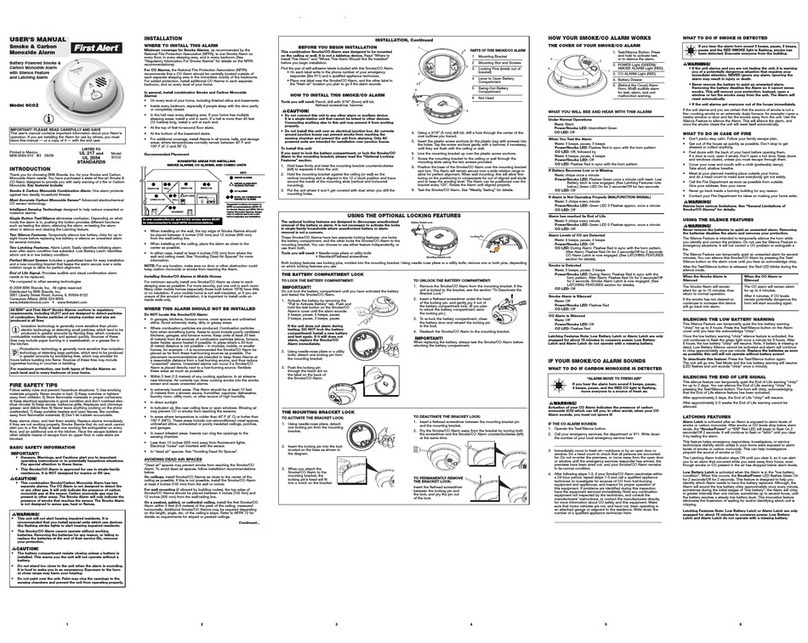
First Alert
First Alert SCO2 user manual
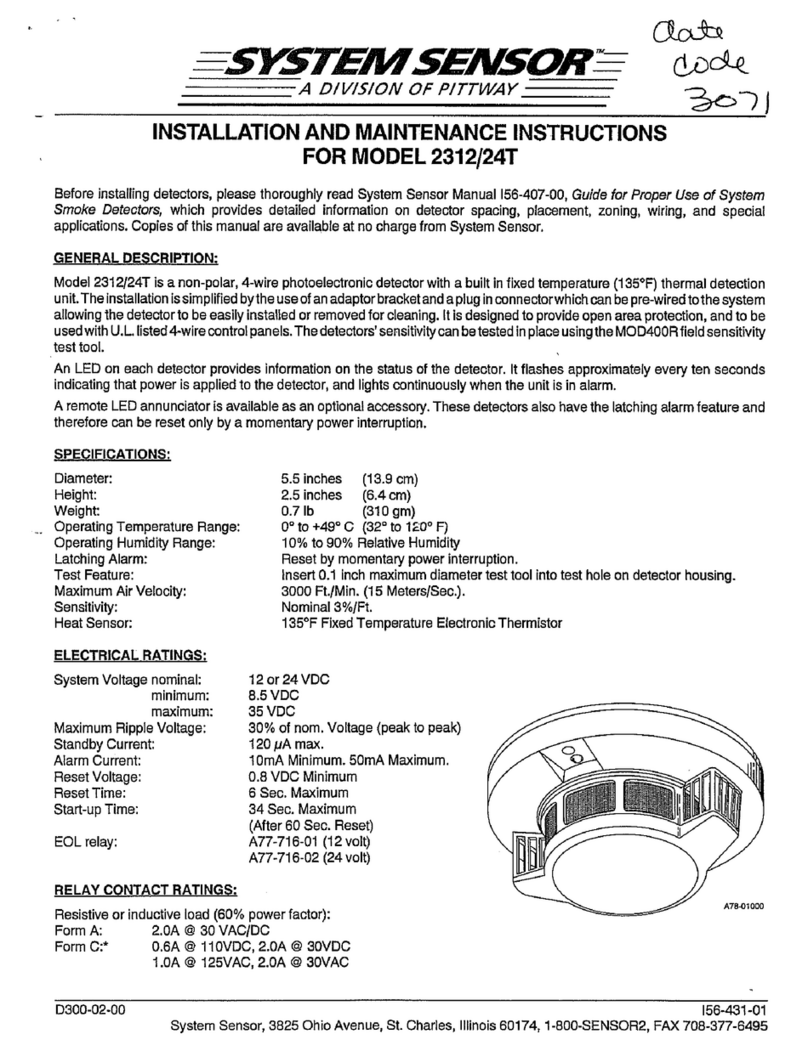
System Sensor
System Sensor 2312/24T Installation and maintenance instructions
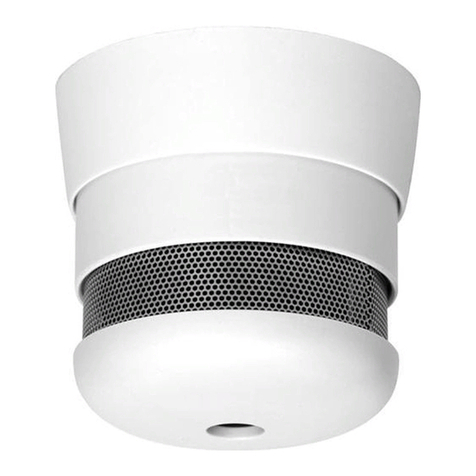
Cavius
Cavius 2007-003 user guide
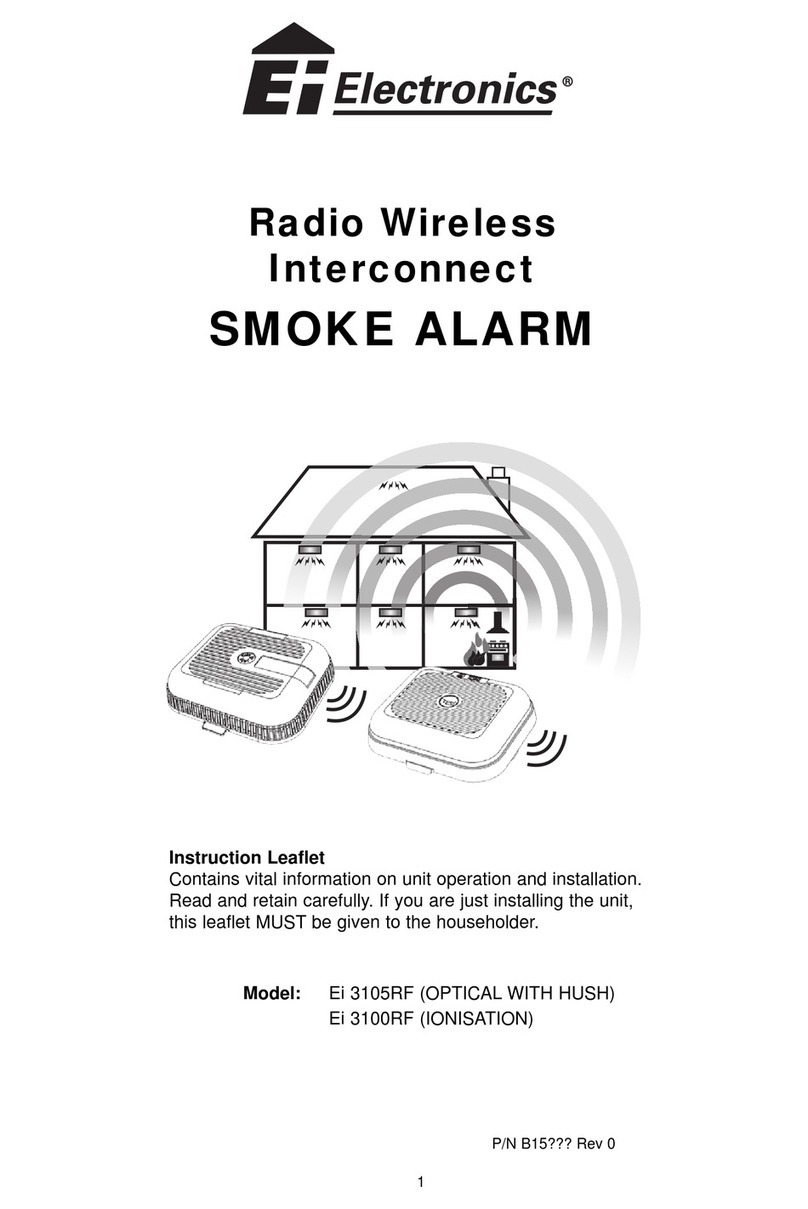
Ei Electronics
Ei Electronics Ei3100RF? Ei3500RF Instruction leaflet
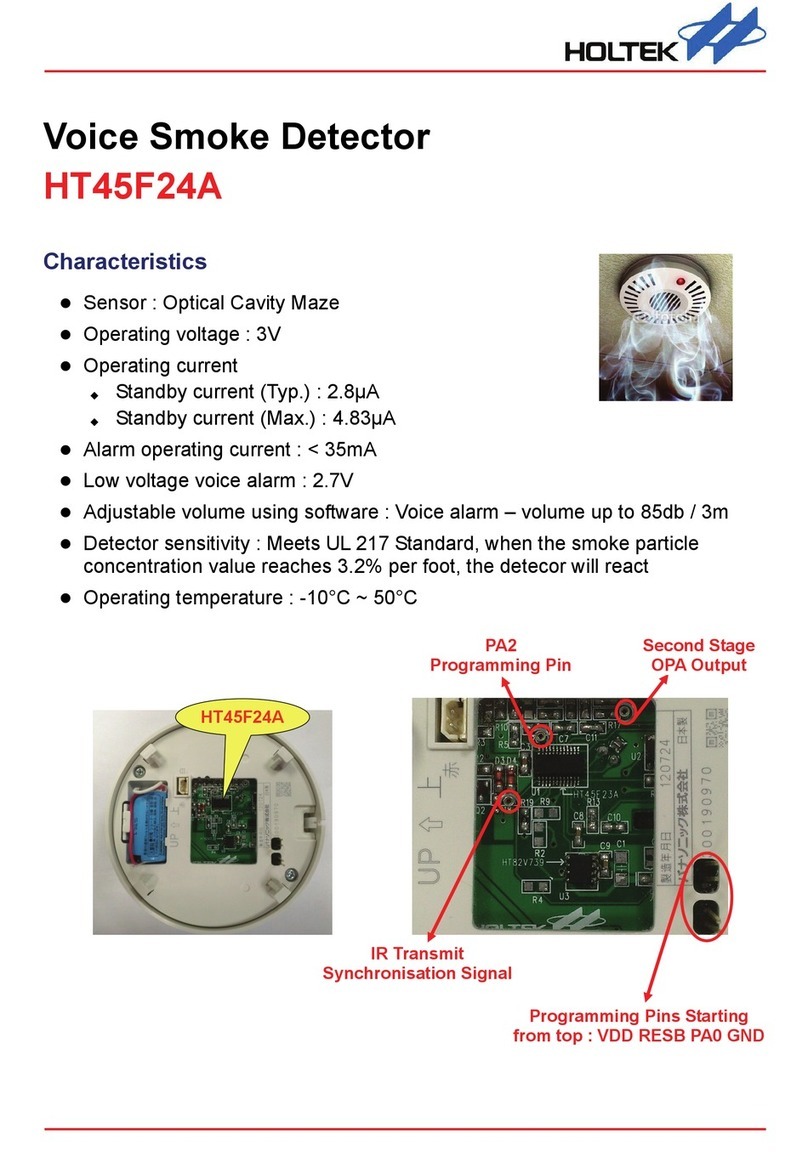
Holtek
Holtek HT45F24A quick start guide
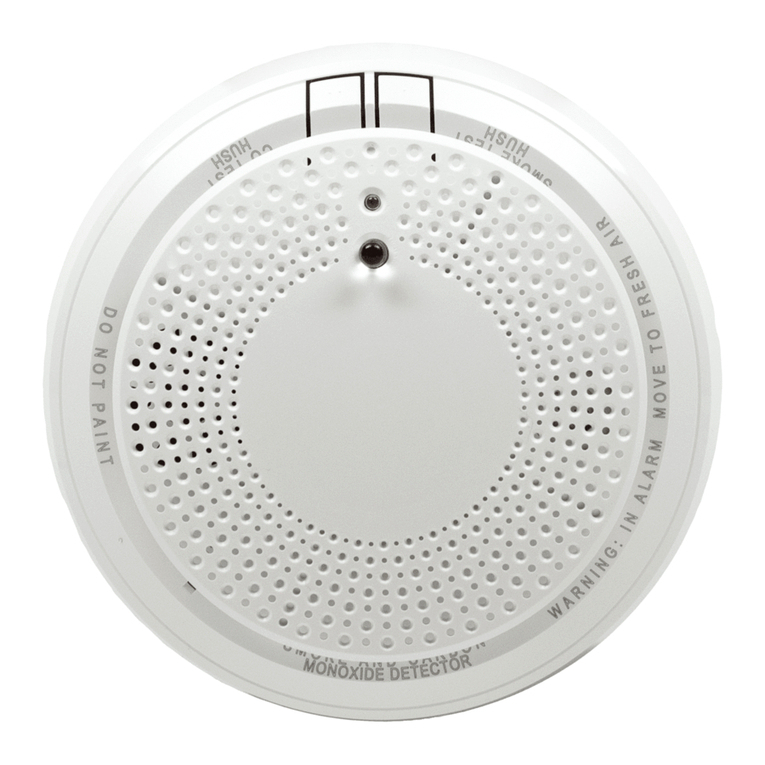
Honeywell Home
Honeywell Home PROSiXCOMBO quick start guide
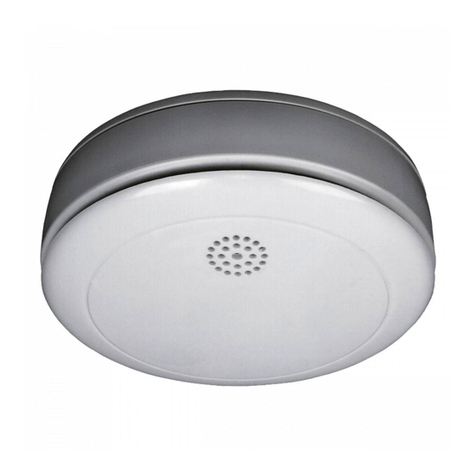
Smartwares
Smartwares 10.006.74 user manual

HST
HST HD201B Installation and maintenance instructions
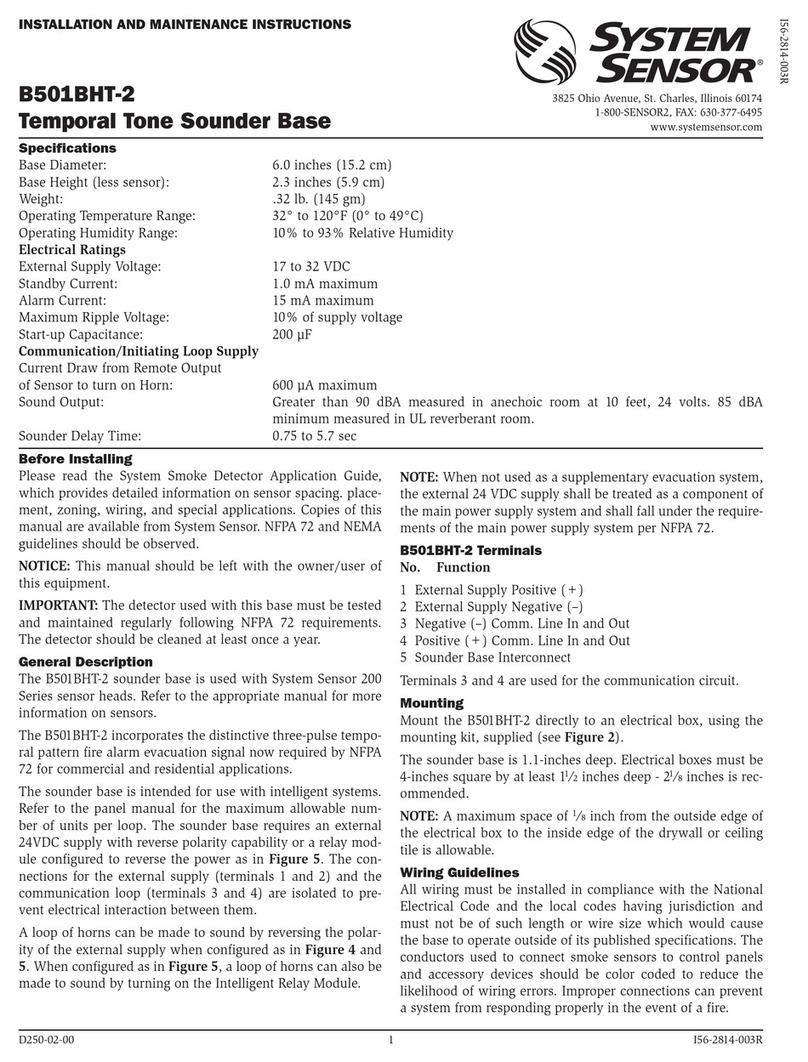
System Sensor
System Sensor B501BHT-2 Installation and maintenance instructions

SILENT KNIGHT
SILENT KNIGHT SD505-DUCT installation instructions
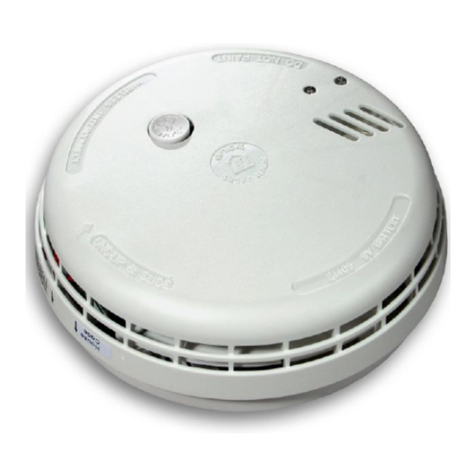
Ei Electronics
Ei Electronics Ei 405C Instruction leaflet
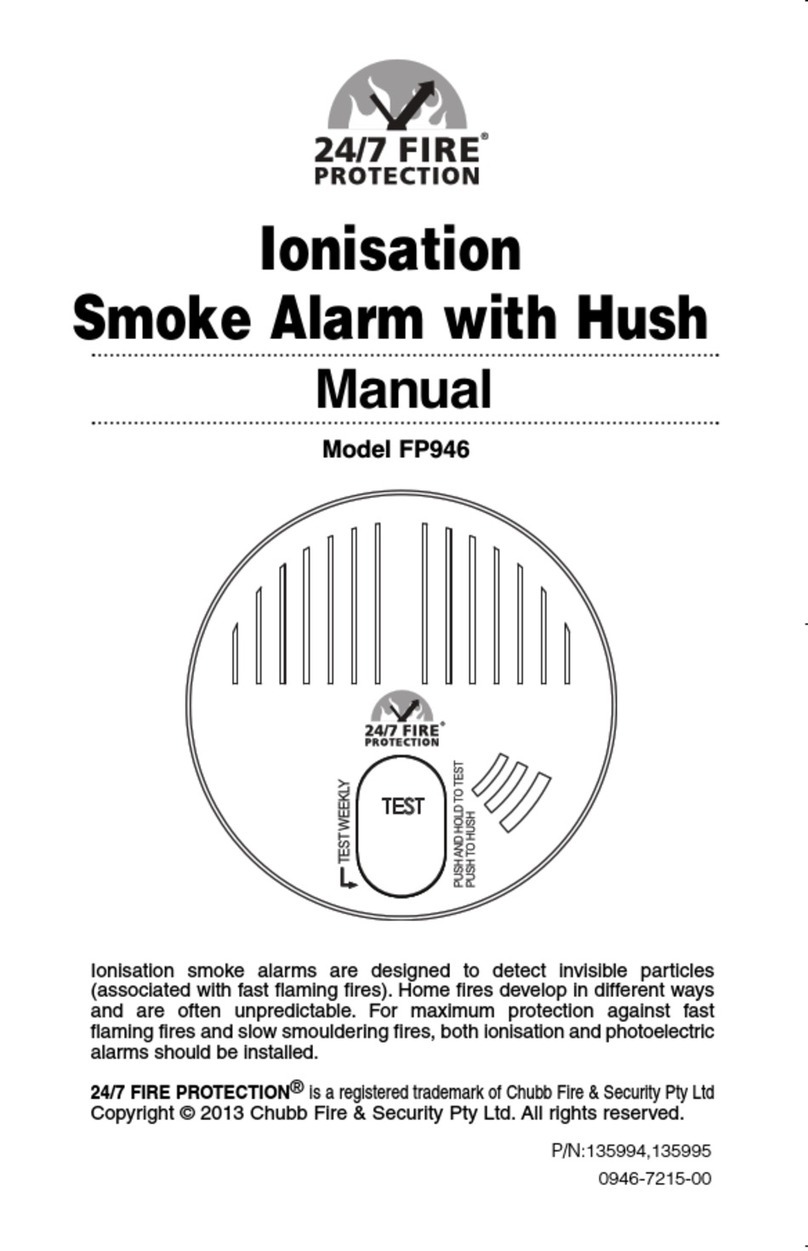
24/7 FIRE PROTECTION
24/7 FIRE PROTECTION FP946 manual




